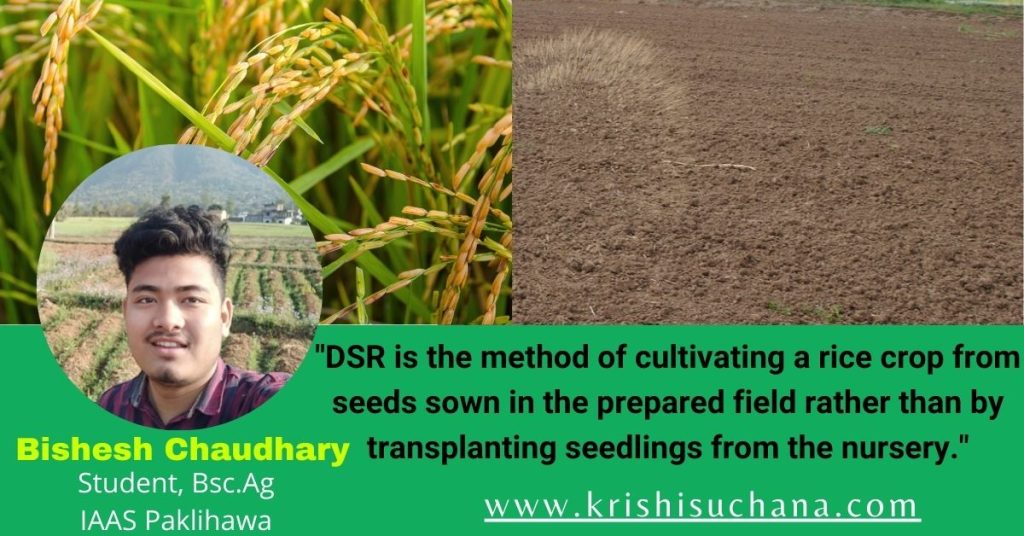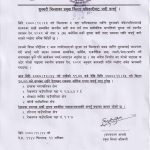Direct Seeded Rice Cultivation Method in Nepal

Rice is one of the most important cereal crops in the world, and most important cereal crops of Nepal and accounts for about 50% of the total agricultural area of the country. It is major source of food after wheat, it fulfills 50% of the calorie requirement of Nepalese people. It is cultivated traditionally through transplanting of 20-25 days old seedlings in all ecological regions of Nepal. There are many problems arising during rice cultivation such as lack of suitable technology, requires high amount of water, expensive labour, high agricultural input, etc and affects the productivity and sustainability of rice cultivation system in Nepal. Direct seeded rice (DSR) in only viable method for high production with low agricultural input. Direct seeded rice (DSR) refers as the resource conservation technology which saves labour, energy, fuel and time, requires less water, low production cost, better soil physical condition for following crops, and less emission of methane gas. The production rate of direct seeded rice cultivation method is higher than other cultivation method on the basis of agricultural input for production.
Direct seeded rice (DSR):
DSR is the method of cultivating a rice crop from seeds sown in the prepared field rather than by transplanting seedlings from the nursery. In this method, farmers used to sow seeds onto dry or wet soil surface, then incorporates the seed either by plowing or harrowing. High yield of rice grains can be gained by adopting various cultural practices i.e. selection of suitable cultivars, proper sowing time, optimum seed rate , proper weed and water management.
Different methods of direct seeded rice:
Rice can be cultivated by two method of direct seeding: dry-DSR and wet-DSR.
- Dry-DSR method: In this seeding method, rice is broadcast or drilled into dry soil and the seed is then covered. This method can be done in different process: (1) broadcasting of dry seeds on unpuddled soil after either zero tillage or conventional tillage, (2) dibbled process in a well prepared field and (3) drilling of seeds in rows after conventional tillage or minimum tillage using a power tiller –operated seeder. A seed-cum-fertilizer drill is used, which after land preparation or in zero tillage condition, places the fertilizer and drills the seeds.
- Wet-DSR method: In this seeding method, pregerminated seeds of rice (radicle 1-3mm) are sown on or into puddled soil. When pregerminated seeds are sown on the surface of puddle soil, the seed environment is mostly aerobic but if pregeminated seeds are drilled into puddle soil, the seed environment is mostle anaerobic. Under wet-DSR seeds can be either broadcasted or sown in line using a drum seeder or an anaerobic seeder with a furrow opener and closer.
Soil type : Medium or heavy textured soils is better for direct seeded crop as direct seeded crop in light soils suffers from iron deficiency which causes remarkable reductions in the yield.
Sowing time: Sowing time is based on the climate and topography of the location. First fortnight of June is the optimum time for direct seeding of coarse rice. As general, sowing time of DSR should be as close as possible to the time of nursery sowing for the planting transplanted rice.
Suitable varieties of rice on the basis of geoghraphical region of Nepal:
- Terai: Chaite-2, Ghaiya-4, Radha-4, Bindeshwori, Sukha dhan-1, Sukha-2 and Sukha-3, tarahara-1, Hardinath-2, Sona Masuli
- Hill: Khumal-4, Khumal-8 and Khumal-10
- High hill: Chhomrong
Seed rate and treatment: About 40-60 kg of rice seed are required per hector is adequate, when using planters with precise seed metering systems. Rice seed should be treated with fungicides like streptocycline 1 g+bavistin 10 g/10 kg seed to reduce seed and soil borne disease like bacterial leaf blight, sheath blight, brown leaf spot and other diseases.
Weed management: Weeds can be controlled by cultural methods like stale seed bed technique, use of surface mulch, cover crops (Sesbania rostrata, Phaseolus radiatus and Vigna unguiculata) and brown manuring can help to reduce weed pressure. Weed management can be also done by using various herbicides like oxadiazon, pendimethalin, oxadiagryl, pretilachlor, etc to destroy weeds immediately.
Advantages from DSR
Direct seeding rice cultivation system provides various banefits to farmers and the environment over conventional practices of puddling and transplanting. The various benefits are listed below:
- Saves time and labour.
- More efficient water use and higher water stress tolerance.
- Easy and fast method of planting.
- Early crop maturity by 7-10 days which allows timely planting of subsequent crops.
- Low agricultural input with higher production.
- Better soil physical condition.
Disadvantages from DSR
In this method seeds are directly sown in the prepared land which may be destroyed by birds and rats, and sudden rain immediately after sowing can adversely affect the crop establishment. Some other disadvantages of this method are listed below:
- Development of herbicide resistance weeds.
- Emergence of weedy rice.
- Increase in soil-borne pathogens such as nematodes.
- Higher emissions of nitrous oxide.
- Nutrient disorders, especially N and micronutrients.
- Stagnant yield.
Conclusion: DSR with better management practices has potential to produce higher yield. DSR reduces cost of production, saves time and labour use, requires less water which encourages farmers to apply this system of planting. As DSR is resource conservation technology and maintains soil environment condition, it is adopted in all over the world.

 एउटा यस्तो विषालु भ्यागुता, जसको मुल्य नै पर्छ ३ लाख, जान्नुहाेस्
एउटा यस्तो विषालु भ्यागुता, जसको मुल्य नै पर्छ ३ लाख, जान्नुहाेस्  भोलि र पर्सि बालबालिकालाई भिटामिन ए खुवाइदै
भोलि र पर्सि बालबालिकालाई भिटामिन ए खुवाइदै  खगराज अधिकारी गण्डकीको मुख्यमन्त्री नियुक्त
खगराज अधिकारी गण्डकीको मुख्यमन्त्री नियुक्त  सुनसरीमा दुवै पक्षबीच सहमति, कर्फ्यु खुकुलो हुदै
सुनसरीमा दुवै पक्षबीच सहमति, कर्फ्यु खुकुलो हुदै  स्टेफेनको शतकमा आयरल्याण्ड वोल्भ्सले नेपाल ए लाई दियो २८५ रनको लक्ष्य
स्टेफेनको शतकमा आयरल्याण्ड वोल्भ्सले नेपाल ए लाई दियो २८५ रनको लक्ष्य 


